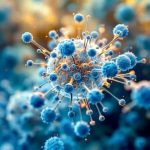Takeaways
- Green tea can reduce iron absorption from food
- Timing matters: drink tea between meals for less impact
- Vitamin C boosts iron uptake, counteracting tea’s effects
- Some people need to be extra careful about iron intake
- Green tea offers health benefits despite iron interaction
- Balance is achievable with smart dietary choices
Green Tea: A Nutritional Powerhouse
Green tea is made from the leaves of the Camellia sinensis plant.[1] People have been drinking it for thousands of years.[2] It is not just a tasty drink, but also contains many helpful nutrients and compounds.
Making green tea involves a straightforward process. Farmers harvest the leaves and quickly heat them. This step prevents the leaves from oxidizing, keeping them green.[3] The final product is a light, refreshing beverage that’s rich in antioxidants.[4]
Green tea is a source of various nutrients. These include vitamins, minerals, and beneficial plant compounds. Catechins, a type of polyphenol, are particularly important. They are responsible for many of green tea’s health advantages.[5]
Studies suggest that green tea may offer several health benefits. It might help improve brain function and promote fat burning.[6] Some research even indicates it could lower the risk of certain cancers.[7] However, the effect of green tea on iron absorption is a subject of some debate.[8]
The Iron Dilemma
Iron is a necessary mineral for our bodies. It plays a key role in creating hemoglobin, which carries oxygen in our blood.[9] A lack of iron can lead to anemia, a condition that causes fatigue and weakness.[10]
Iron deficiency is a common nutritional problem around the world. The World Health Organization identifies it as the most widespread nutritional disorder.[11] This deficiency affects people of all ages, though some groups face a greater risk.
Our bodies absorb two types of iron from foods we consume. Heme iron is found in animal-based products, while non-heme iron comes from plants.[12] The body absorbs heme iron more efficiently than non-heme iron.[13]
| Iron Type | Sources | Absorption Rate |
|---|---|---|
| Heme | Meat, fish, poultry | 15-35% |
| Non-heme | Plants, fortified foods | 2-20% |
Iron absorption is affected by several factors. These include the specific type of iron consumed and the other foods eaten at the same time. Certain drinks, like green tea, can also influence how well we absorb iron.[14]
Green Tea and Iron Absorption: The Interaction
Green tea and iron have a complex relationship. Research indicates that green tea can reduce the amount of iron absorbed from food.[15] This effect is more pronounced with non-heme iron, the type found in plant-based foods.[16]
The polyphenols in green tea are responsible for this interaction. These compounds bind to iron in the digestive system.[17] This binding action makes it more difficult for the body to absorb the iron.
Several factors can influence how much green tea affects iron absorption:
- The amount of tea consumed
- The strength of the tea
- When it’s drunk in relation to meals
- The iron status of the person drinking it
For most people, this interaction is not a serious concern.[18] However, people who are at risk of iron deficiency should be aware of this effect.
The Science Behind the Interaction
To understand this interaction, it’s useful to look at how iron is absorbed. Iron absorption mainly takes place in the small intestine.[19] Specialized cells in the intestine are responsible for taking up iron from digested food.
The compounds in green tea interfere with this absorption process. They attach to iron, creating complexes. These complexes are too large for the body to absorb easily.
Recent studies offer further information on this interaction. A review in 2017 found that tea polyphenols can reduce non-heme iron absorption by as much as 90%.[20] However, the impact varies depending on multiple factors.
| Study | Findings |
|---|---|
| Hurrell et al. (1999) | Green tea reduced iron absorption by 63% |
| Thankachan et al. (2008) | Tea with meals lowered iron status in anemic women |
| Ahmad Fuzi et al. (2017) | Tea between meals had less impact on iron levels |
These findings illustrate the complex relationship between tea and iron. They also suggest strategies to reduce any negative impact.
Balancing Green Tea and Iron Intake
It’s not necessary to completely avoid green tea to maintain good iron levels. By making a few smart choices, you can enjoy both.
Timing is an important factor. Consuming green tea between meals can minimize its effect on iron absorption.[21] It’s helpful to wait at least one hour between drinking tea and eating iron-rich foods.[22]
Here are some steps to take to maximize iron absorption while still enjoying green tea:
- Drink tea between meals, not with them
- Include vitamin C-rich foods with iron sources
- Choose iron-fortified foods when possible
- Consider cooking in cast iron pans
- If at risk for iron deficiency, talk to a doctor about supplements
By taking these steps, you can help maintain healthy iron levels while still enjoying green tea.
Green Tea Benefits for Iron-Related Conditions
While green tea can reduce iron absorption, there can also be some benefits. In some cases, green tea might actually be helpful for certain iron-related health problems.[23]
For people who have iron overload disorders, green tea could be helpful.[24] These disorders cause an excessive buildup of iron in the body. Green tea’s ability to bind to iron might help manage these conditions.
Green tea’s antioxidants also play a role in iron metabolism. They can help protect cells from the damaging effects of excess iron.[25] This could be particularly helpful for individuals with hereditary hemochromatosis.
More research is needed in this specific area. If you have an iron-related health condition, it’s always a good idea to consult with your doctor before making any dietary changes.
Considerations for Different Population Groups
Vegetarians and Vegans
People who follow plant-based diets may face specific challenges with iron. Their diets contain only non-heme iron, which is more difficult to absorb.[26] Green tea can reduce this absorption even further.
If you follow a plant-based diet, you should pay extra attention to your iron intake. Make sure to include plenty of iron-rich plant foods like lentils, beans, and leafy greens. Pairing these with vitamin C can also help improve absorption.[27]
Try drinking green tea between meals instead of with them. This can help reduce its impact on iron absorption.
Pregnant Women
Pregnancy increases the need for iron. The body uses iron to make additional blood for the developing baby.[28] This means that iron absorption is particularly important during pregnancy.
Pregnant women should be careful about their green tea consumption. It’s best to limit how much you drink and avoid having it with meals.[29] Always follow the advice of your healthcare provider regarding diet during pregnancy.
Some doctors recommend that pregnant women avoid green tea completely. This is because of its caffeine content and the potential effects on iron absorption.[30]
Athletes
Athletes, particularly those involved in endurance activities, often need more iron than the average person.[31] They lose iron through sweat and have greater overall iron requirements.
For athletes concerned about iron levels, timing is very important. It’s best to drink green tea well before or after workouts and meals.[32] This approach can help maintain sufficient iron while still enjoying the benefits of green tea.
Consider consulting with a sports nutritionist. They can help develop a diet plan that meets your iron needs while also including green tea.
Alternative Tea Options
If you’re worried about iron absorption, there are other tea options. Many herbal teas do not affect iron uptake in the same way that green tea does.[33]
Herbal teas are made from various herbs, fruits, and spices. They do not contain the same polyphenols that are found in true teas.[34] This means they are less likely to interfere with iron absorption.
Here are some examples of herbal teas that do not affect iron absorption:
- Chamomile
- Peppermint
- Rooibos
- Hibiscus
- Ginger
These teas offer various health benefits without affecting iron levels. They can be a good choice if you’re at risk of iron deficiency.
Optimizing Iron Absorption
To maximize the iron you get from your diet, consider these points. Certain foods and nutrients can enhance iron absorption.
Vitamin C is a strong enhancer of iron uptake. It helps convert iron into a more absorbable form.[35] Foods that are rich in vitamin C include citrus fruits, bell peppers, and strawberries.
Here are some steps to create meals that are better for iron absorption:
- Include a vitamin C source with iron-rich foods
- Cook acidic foods in cast iron pans
- Avoid calcium-rich foods with iron sources
- Include meat, fish, or poultry with plant-based iron sources
- Soak or sprout grains and legumes before cooking
By following these steps, you can improve your body’s iron absorption. This can be particularly helpful if you are at risk of iron deficiency.
When to Seek Professional Advice
It’s important to know when to seek medical advice about iron. Some symptoms of low iron levels include:
- Unusual tiredness
- Pale skin
- Shortness of breath
- Headaches
- Dizziness
- Cold hands and feet
If you experience any of these symptoms, it’s a good idea to see a doctor. They can test your iron levels and recommend any needed dietary changes or supplements.
Testing for iron levels usually involves a blood test. This test measures various markers of iron in your body.[36] Your doctor can interpret the results and recommend any necessary steps.
It is important to remember that both too little and too much iron can cause health issues.[37] Always consult with a healthcare provider before taking iron supplements.
FAQ: People Also Ask
How much does green tea affect iron absorption?
Can I drink green tea if I’m anemic?
What’s the best time to drink green tea for someone concerned about iron levels?
Are there any types of green tea that don’t affect iron absorption?
How long should I wait after eating iron-rich foods to drink green tea?
Does adding milk to green tea change its effect on iron absorption?
Can green tea help with iron overload conditions?
Are there any iron supplements that can be taken with green tea?
Conclusion
Green tea and iron absorption are linked in a complex way. While green tea can reduce the amount of iron absorbed, it does not mean you need to avoid it entirely.
Balance is key. By being mindful of when you consume tea and including foods that enhance iron absorption in your diet, you can enjoy the benefits of green tea without harming your iron levels.
It is important to remember that each person’s needs are different. What works well for one person might not work as well for another. If you have concerns about your iron levels, talk to your healthcare provider.
Green tea has numerous health benefits. By making some mindful choices, you can incorporate it into a healthy diet that provides enough iron. The goal is to find a balanced approach that supports your health and lets you enjoy this traditional beverage.
The Camellia sinensis plant is the source for all true teas, including green tea, black tea, and white tea.
Source: “Recent Advances in the Understanding of the Health Benefits and Molecular Mechanisms Associated with Green Tea Polyphenols” https://pubmed.ncbi.nlm.nih.gov/30653316/
The practice of drinking tea, including green tea, dates back thousands of years, primarily in East Asia.
The heating process, often through steaming or pan-firing, deactivates enzymes that would otherwise cause oxidation and result in a darker tea.
The antioxidants in green tea, particularly catechins, contribute to its health benefits and refreshing flavor.
Source: “Recent Advances in the Understanding of the Health Benefits and Molecular Mechanisms Associated with Green Tea Polyphenols” https://pubmed.ncbi.nlm.nih.gov/30653316/
Catechins, such as EGCG, are a type of antioxidant with various properties that have been linked to health benefits.
Source: “Recent Advances in the Understanding of the Health Benefits and Molecular Mechanisms Associated with Green Tea Polyphenols” https://pubmed.ncbi.nlm.nih.gov/30653316/
Research suggests that green tea may have some beneficial effects on brain function and metabolism, but more robust clinical trials are needed to confirm.
Source: “Recent Advances in the Understanding of the Health Benefits and Molecular Mechanisms Associated with Green Tea Polyphenols” https://pubmed.ncbi.nlm.nih.gov/30653316/
While some studies suggest a link between green tea consumption and lower cancer risk, the results are inconsistent. More rigorous research is needed to confirm any definitive relationship.
Source: “Recent Advances in the Understanding of the Health Benefits and Molecular Mechanisms Associated with Green Tea Polyphenols” https://pubmed.ncbi.nlm.nih.gov/30653316/
While it is established that green tea can reduce iron absorption, the magnitude of this effect and its practical implications are continuously being investigated.
Source: “The Impact of Tannin Consumption on Iron Bioavailability and Status: A Narrative Review” https://pubmed.ncbi.nlm.nih.gov/29955693/
Iron is a critical component of hemoglobin, the protein in red blood cells responsible for carrying oxygen throughout the body.
Anemia, often caused by iron deficiency, is characterized by reduced red blood cell count and hemoglobin levels, leading to symptoms like fatigue and weakness.
Source: “Household environment associated with anaemia among children aged 6–59 months in Ethiopia: a multilevel analysis of Ethiopia demographic and health survey (2005–2016)” https://www.ncbi.nlm.nih.gov/pmc/articles/PMC10823679/
The World Health Organization (WHO) has identified iron deficiency as one of the most prevalent nutritional deficiencies worldwide.
Source: “Household environment associated with anaemia among children aged 6–59 months in Ethiopia: a multilevel analysis of Ethiopia demographic and health survey (2005–2016)” https://www.ncbi.nlm.nih.gov/pmc/articles/PMC10823679/
Heme iron is found in animal products such as meat, poultry, and fish. Non-heme iron is found in plant-based foods like lentils, beans, and leafy greens.
The body more readily absorbs heme iron compared to non-heme iron, primarily because it is not as affected by other dietary factors.
Compounds in green tea, such as polyphenols, can interfere with iron absorption by binding to it in the digestive system.
Source: “The Impact of Tannin Consumption on Iron Bioavailability and Status: A Narrative Review” https://pubmed.ncbi.nlm.nih.gov/29955693/
Research has shown that green tea consumption can reduce the absorption of iron, especially non-heme iron.
Source: “The Impact of Tannin Consumption on Iron Bioavailability and Status: A Narrative Review” https://pubmed.ncbi.nlm.nih.gov/29955693/
The polyphenols in green tea are more likely to interfere with the absorption of non-heme iron, the type found in plant-based foods, compared to heme iron.
Source: “The Impact of Tannin Consumption on Iron Bioavailability and Status: A Narrative Review” https://pubmed.ncbi.nlm.nih.gov/29955693/
Polyphenols, such as catechins, in green tea can bind to iron in the digestive tract, forming complexes that are difficult for the body to absorb.
Source: “The Impact of Tannin Consumption on Iron Bioavailability and Status: A Narrative Review” https://pubmed.ncbi.nlm.nih.gov/29955693/
Healthy individuals with balanced diets and sufficient iron intake are unlikely to experience significant negative effects from the interaction between green tea and iron absorption.
The specialized cells in the lining of the small intestine are responsible for absorbing most of the iron from digested food.
A 2017 review found that tea polyphenols can reduce non-heme iron absorption by up to 90%, but the impact varies depending on multiple factors such as the concentration of tea and timing of consumption.
Source: “The Impact of Tannin Consumption on Iron Bioavailability and Status: A Narrative Review” https://pubmed.ncbi.nlm.nih.gov/29955693/
Consuming green tea between meals rather than with meals allows for greater iron absorption from food, as the polyphenols in tea are less likely to interfere with iron from a previous meal.
Waiting at least one hour after eating iron-rich foods allows enough time for most iron to be absorbed before polyphenols in green tea can interact with it.
Green tea’s iron-binding properties might be beneficial in conditions characterized by iron overload, but more specific research is needed to confirm.
Green tea’s ability to bind to iron might assist in managing iron overload disorders by reducing iron absorption, but further study is needed to determine its effectiveness.
The antioxidant properties of green tea may offer some protective effects against the harmful effects of excess iron on cells, but more research is needed.
Individuals following plant-based diets need to be more mindful of their iron intake and strategies to improve iron absorption, because non-heme iron is less bioavailable than heme iron.
Vitamin C helps convert non-heme iron to a more bioavailable form, promoting its absorption in the digestive system.
Pregnancy significantly increases iron requirements to support the growing fetus and the increased blood volume in the mother.
Due to potential interference with iron absorption, and concerns with caffeine, pregnant women should limit their green tea intake and avoid consuming it with meals.
Because of concerns regarding its caffeine content and its potential to affect iron absorption, some doctors may recommend pregnant women to avoid green tea.
Athletes have increased iron needs due to iron losses through sweat, and the demands on the body’s red blood cells. This is especially true for endurance athletes.
Athletes should consider the timing of their green tea consumption to avoid interfering with iron absorption, particularly around meals and workouts.
Unlike green tea, which contains polyphenols that interfere with iron absorption, herbal teas do not typically have the same impact.
Herbal teas are made from a variety of plant materials and lack the specific type of polyphenols found in Camellia sinensis tea leaves.
Vitamin C helps to convert non-heme iron to a more readily absorbed form in the digestive system.
Blood tests are commonly used to measure markers such as serum ferritin, serum iron, and total iron-binding capacity to assess iron status.
Both iron deficiency (anemia) and iron overload (hemochromatosis) can lead to various health issues, highlighting the importance of maintaining balanced iron levels.
While green tea can reduce non-heme iron absorption, the effect can vary depending on factors such as the strength of the tea, the time it is consumed relative to meals, and the individual.
Source: “The Impact of Tannin Consumption on Iron Bioavailability and Status: A Narrative Review” https://pubmed.ncbi.nlm.nih.gov/29955693/
Due to potential interference with iron absorption, anemic people should avoid consuming green tea with meals and should consult with their doctor for personalized advice based on their individual iron levels.
Consuming green tea between meals, at least an hour before or after eating, can help reduce its impact on iron absorption from food.
All true green teas, derived from the Camellia sinensis plant, contain polyphenols that can interfere with iron absorption. Herbal teas lack these specific compounds and do not have the same impact on iron absorption.
Waiting at least one hour after eating iron-rich foods allows sufficient time for the body to absorb iron before polyphenols from green tea can interfere with the process.
The addition of milk does not significantly impact the ability of polyphenols in green tea to bind to iron, thus having a negative impact on its absorption.
Green tea may potentially help manage iron overload due to its iron-binding properties, however, any dietary change in those with iron overload conditions should be discussed with a medical professional.
It is recommended that iron supplements not be taken concurrently with green tea, and that a doctor or pharmacist be consulted for timing recommendations.



